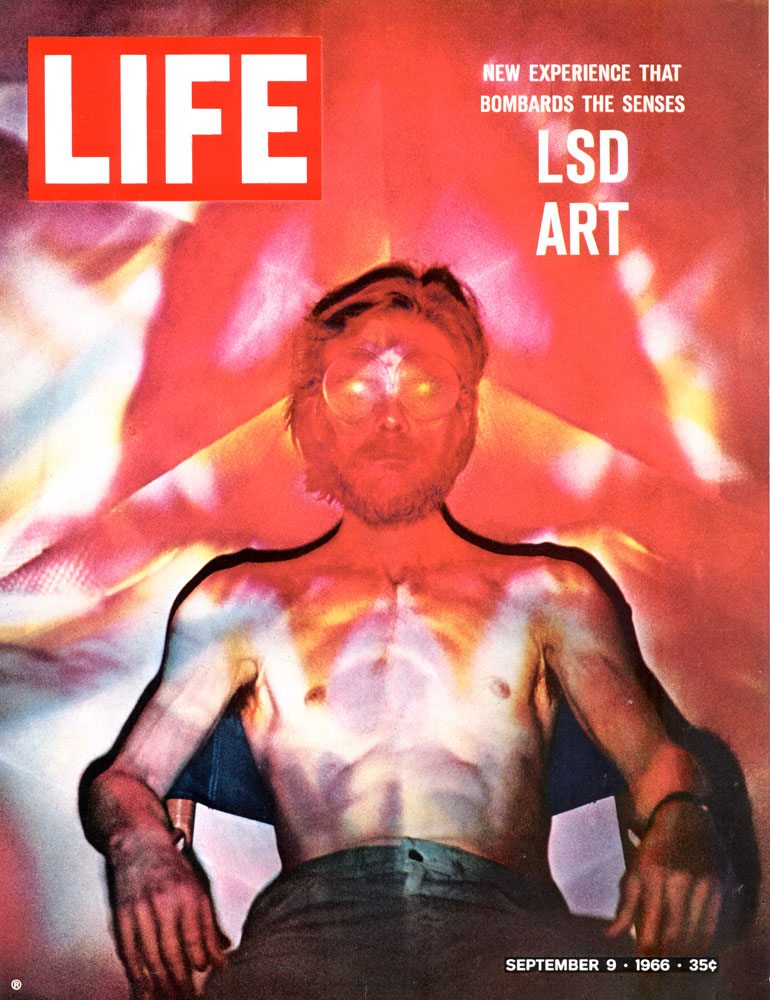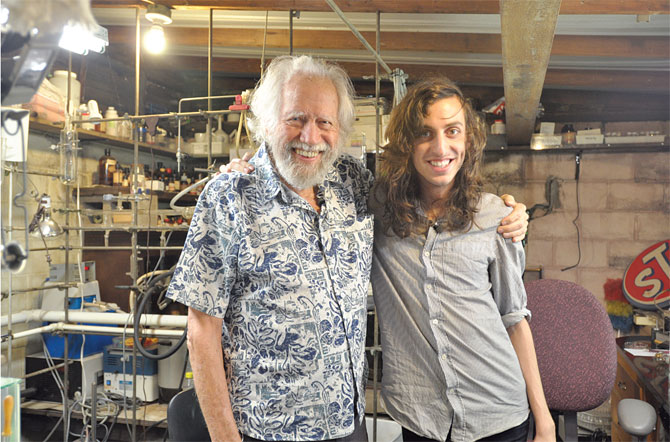LSD as a form of psychiatric treatment. Stranded on the beaches of our waking mind…
Another effect from the “gaining of altitude” revolved around the recording of the heightening of consciousness. This was usually described as the growing intensification of colour. Flowers, leaves, grass and trees seen with tremendous vividness, a sort of Van Gogh type intensity. Intensification of sound, with music itself becoming unbearably intense, searingly emotional.

—Image from the cover of LIFE magazine, September 9, 1966, accompanied by the headline, “New Experience That Bombards the Senses: LSD Art.”
Read more: http://life.time.com/culture/life-photos-from-an-lsd-inspired-art-show-1966/#ixzz2cbISYydp—
Another, common effect of LSD was even stranger and deeper. The subject feeling that time itself, usually urgent, pressing, hurried or its opposite- slack, lagging,heavy, was now in @right time.@ Now an ample store of unhastened attention brought by eye and ear, a stretching of tie permitting a full use of every moment. This is followed by a transition where the whole outside world becomes a composition that embraces and interfuses everything; a composition though constantly changing, is also, in a strange paradox, all the while complete and instant in a fathomless peace. An all-pervading Energy where the subject realizes they cannot be isolated, and Time appears to have stopped or disappeared. The ego dies, its protective barriers shed without anxiety about past or future.

—Although Alexander Shulgin is not exactly a household name, he is unquestionably the most important psychedelic chemist who has ever lived. Those who do know of him are usually only familiar with his role in the rediscovery and popularization of MDMA. But MDMA is just one of 100-plus unique chemicals that compose Shulgin’s pharmacopeia, which extends so far into the unknown that he often has to invent new terms to describe the effects (“eye romp” is one of my favorites). The drugs are selective auditory and tactile hallucinogens, psychedelics that dilate time or send the user into a state of amnesiac confusion, antidepressants, aphrodisiacs, stimulants, empathogens, entactogens, neurotoxins, and at least one very profitable insecticide. They are also some of the most valuable medicines known to man, and although only a fraction of them have been formally studied, they are the best tools we have for understanding the chemical composition of the human mind.—click image for source…
Psychoanalysis is concerned mainly with the conflict between sexual urges and the taboos imposed by society, and with the effects of these conflicts on everyday living. But the traffic usually associated with the hallucinogenic voyage deal with data apparently belonging to those higher registers of the mind that are difficult to quantify. It is true, that mystics and saints have reported, time and again, out-of-this-world experiences that did change their lives and bring a “better order” in their living. But these experiences came as the result of many years of severe mental and physical discipline carried out within a doctrinal frame of reference, which often brought them to the brink of insanity. For many, the experience was only a brief flash. Fro some it came two or three times during a lifetime of discipline. Finding a short-cut to reach these states teased psychologists for many years, and William James, saw that if it was to be solved, the experimenter must use psychophysical means on himself. ( to be continued)…
ADDENDUM:
(see link at end)…From the very beginning, psychiatrists were aware that LSD, like most other medicaments, poses hazards. The hazards visible during the early years were summed up in a classic 1960 paper, “Lysergic Acid Diethylamide: Side Effects and Complications,” by Dr. Sidney Cohen.

—It must be made clear that a visionary experience,however attained, may have beneficial effects, adverseones or none, whatever. It can be suppressed and for-gotten, it can reinforce clandestine notions of grandi-osity or it can “put a floor under me so that I can never again sink into complete aloneness and hopelessness.”Actually, nothing is understood in detail, but the over-all feeling of pure knowing pervades. It can, as will beseen, reshuffle the mazeway of doubt and depression.Old destructive patterns of behavior may suddenly beabandoned after an overpowering emotional experience.The learning of new attitudes and techniques maybecome easier in a post-transcendent period—Dr. Sidney Cohen. click image for link…
Dr. Cohen sent a questionnaire to 66 researchers who were known to have administered LSD or mescaline to humans, either therapeutically or experimentally. Forty-four of them replied; they had administered LSD on more than 25,000 occasions to nearly 5,000 men and women. Dr. Cohen also searched the medical literature for published reports of adverse effects.
From the physical point of view, LSD was found to have a remarkable record. “No instance of serious, prolonged physical side effects was found either in the literature or in the answers to the questionnaires. When major untoward reactions occurred they were almost always due to psychological factors.” No physical complications were observed even when LSD was
n to skid-row alcoholics with impaired liver function and generally deteriorated health.As for adverse psychological reactions, Dr. Cohen noted that the published LSD literature “directly records only one suicide and that in a schizophrenic patient, and a small number of short, self-limited psychotic reactions and other lesser side effects.”
Dr. Cohen’s survey of LSD therapists, however, turned up several kinds of adverse psychological reactions. These he divided into immediate and subsequent.
The most common, but still infrequent, immediate problem [Dr. Cohen reported] was one of unmanageability. This apparently occurs when insight into the situation is lost and the individual acts upon delusory, usually paranoids] ideas. Instances of running away from the tester, disrobing, or accidental self injury were described. . . .
Panic episodes were likewise mentioned. When these develop early they seem to represent the terror involved with the loss of ego controls. At the height of the reaction panic may be precipitated…. Finally, after many hours of frightening dissociation the subject could develop an intense fear that he will not be able to get back to his ordinary state. Read More:http://www.druglibrary.org/schaffer/library/studies/cu/cu48.html





 COMMENTS
COMMENTS